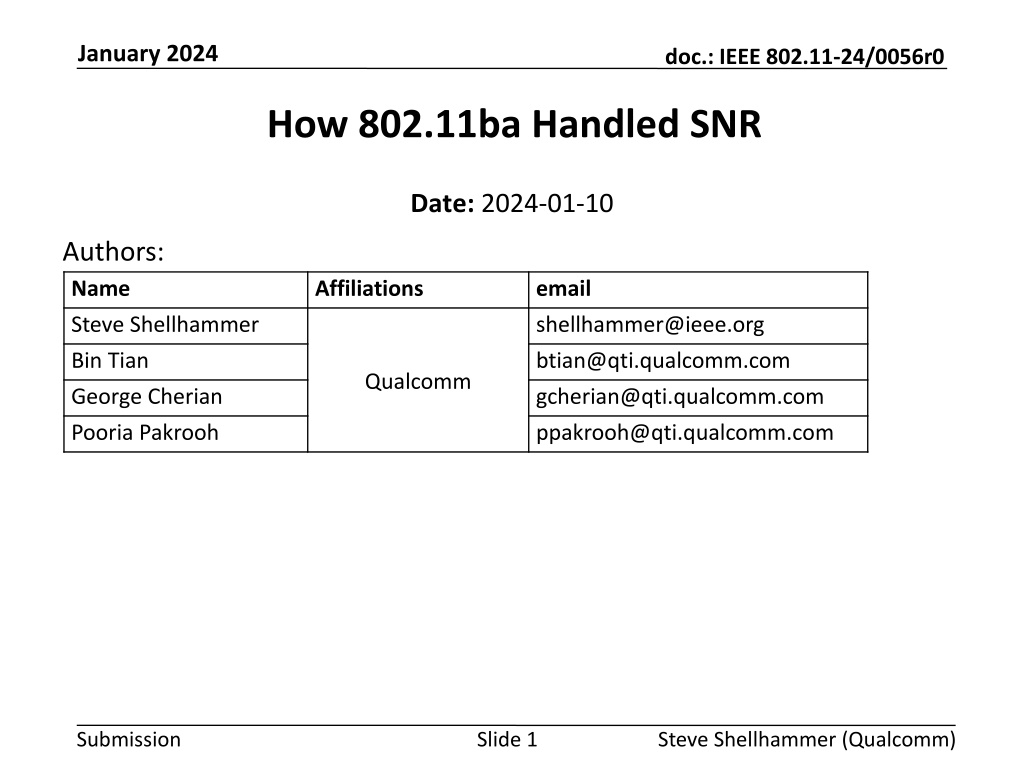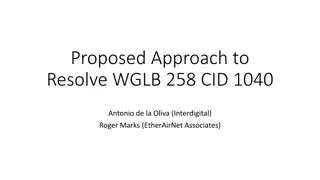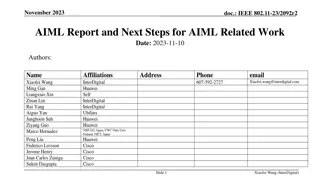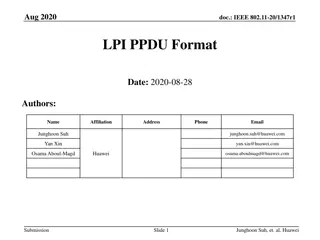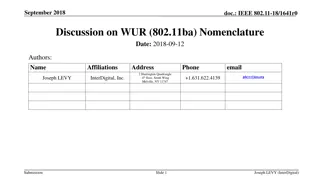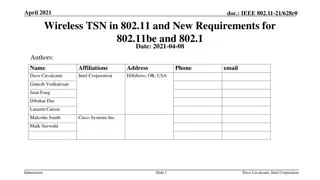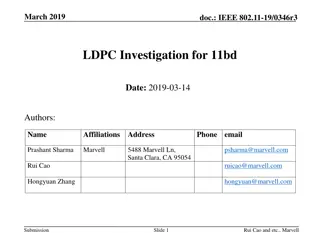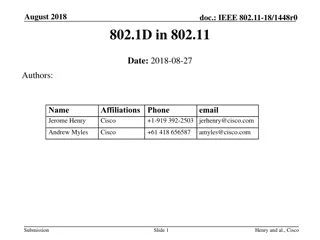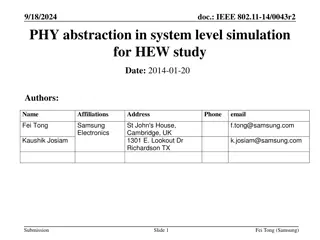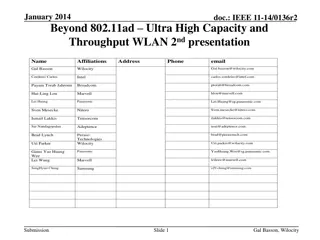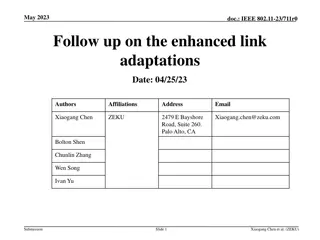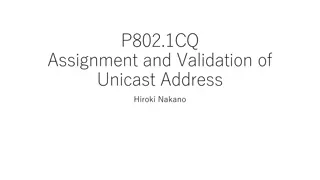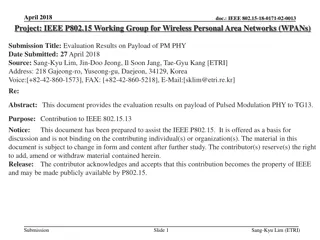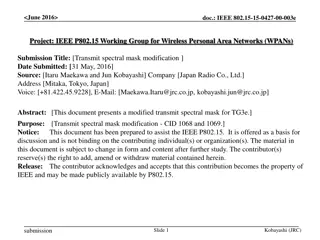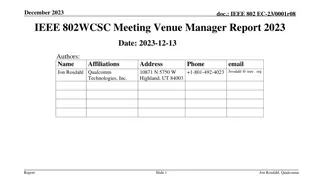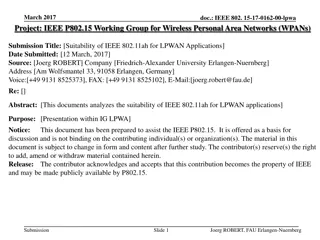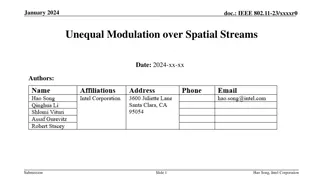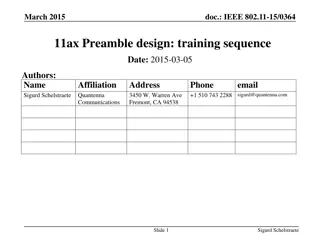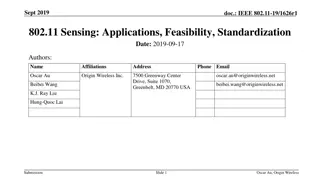How 802.11ba Handled SNR
The document delves into how IEEE 802.11ba manages Signal-to-Noise Ratio (SNR) requirements, comparing them to other standards, defining SNR bandwidth, channel models used, receiver noise figure, and transmit power considerations.
Download Presentation

Please find below an Image/Link to download the presentation.
The content on the website is provided AS IS for your information and personal use only. It may not be sold, licensed, or shared on other websites without obtaining consent from the author.If you encounter any issues during the download, it is possible that the publisher has removed the file from their server.
You are allowed to download the files provided on this website for personal or commercial use, subject to the condition that they are used lawfully. All files are the property of their respective owners.
The content on the website is provided AS IS for your information and personal use only. It may not be sold, licensed, or shared on other websites without obtaining consent from the author.
E N D
Presentation Transcript
January 2024 doc.: IEEE 802.11-24/0056r0 How 802.11ba Handled SNR Date: 2024-01-10 Authors: Name Affiliations email Steve Shellhammer shellhammer@ieee.org Bin Tian George Cherian btian@qti.qualcomm.com gcherian@qti.qualcomm.com Qualcomm Pooria Pakrooh ppakrooh@qti.qualcomm.com Submission Slide 1 Steve Shellhammer (Qualcomm)
January 2024 doc.: IEEE 802.11-24/0056r0 Introduction Since AMP needs will utilize a WUR it is useful to review how 802.11ba handled SNR There were two possible ways that 802.11ba could have handled SNR requirements and analysis 1. Set range requirements, propagation, models, etc. to get required SNR 2. Use the same models as other 802.11 standards and compare to those SNR values In 802.11ba we used Method #2 This allows easy comparison to other 802.11 standards o For example, the AWGN of 6 Mb/s OFDM PHY is easily available in reference documents In this presentation we provided some background on how SNR was handled in 802.11ba, for consideration by AMP group Submission Slide 2 Steve Shellhammer (Qualcomm)
January 2024 doc.: IEEE 802.11-24/0056r0 SNR Bandwidth Definition The WUR portion of the WUR PPDU bandwidth is 4 MHz However, to make comparison with other 802.11 standards in 802.11ba we used a 20-MHz noise bandwidth for SNR That makes SNR comparisons to 20-MHz 802.11 standard straightforward This of course makes the 20-MHz SNR value 7 dB lower than the 4-MHz SNR value. So, it is easy to translate between these noise bandwidths. Submission Slide 3 Steve Shellhammer (Qualcomm)
January 2024 doc.: IEEE 802.11-24/0056r0 Channel Models For comparison to 20-MHz 802.11 standard all simulations were done using the 802.11n Channel Models The channel models used in 802.11ba were o 20-MHz AWGN Channel Model o 20-MHz Channel Model D There are reference documents with simulations of 802.11n easily available for comparison Submission Slide 4 Steve Shellhammer (Qualcomm)
January 2024 doc.: IEEE 802.11-24/0056r0 Receiver Noise Figure It was expected that 802.11ba would have a higher receiver noise figure than a typical 802.11n receiver This is because of the low-power requirements in 802.11ba compared to 802.11n In 802.11ba the receiver noise figure was set as being 8 dB higher than a typical 802.11n receiver [1] o This of course depends on implementation This provides a straightforward way of comparing the 802.11ba SNR with the 802.11n SNR Submission Slide 5 Steve Shellhammer (Qualcomm)
January 2024 doc.: IEEE 802.11-24/0056r0 Transmit Power In some regulatory domains the allowed transmit power can depend on the transmit bandwidth In 802.11ba this was studied to make a relative comparison to a 20-MHz bandwidth 802.11 standard [1] Submission Slide 6 Steve Shellhammer (Qualcomm)
January 2024 doc.: IEEE 802.11-24/0056r0 Regulated Maximum Allowed Transmit Power [1] ? (dBm) Region Band (GHz) Power Limit for AP (dBm) PSD Limit for AP (dBm/MHz) 20 MHz 802.11 Limit (dBm) 4 MHz WUR Limit (dBm) 2.4 30 N/A 30 30 0 5.15-5.25 30 17 30 23 -7 5.25-5.35 24 11 24 17 -7 FCC 5.47-5.725 24 11 24 17 -7 5.725-5.85 30 33 30 30 0 2.4 20 10 20 16 -4 5.15-5.25 23 10 23 16 -7 5.25-5.35 23 10 23 16 -7 ETSI 5.47-5.725 30 17 30 23 -7 5.725-5.85 N/A 2.4 20 10 20 16 -4 5.15-5.25 23 10 23 16 -7 5.25-5.35 23 10 23 16 -7 China 5.47-5.725 N/A 5.725-5.85 30 13 26 19 -7 Submission Slide 7 Steve Shellhammer (Qualcomm)
January 2024 doc.: IEEE 802.11-24/0056r0 Regulatory Transmit Power Summary [1] ? dBm Frequency Band (GHz) Region FCC 0 2.4 ETSI & China -4 5.15-5.25 FCC, ETSI & China -7 5.25-5.35 FCC, ETSI & China -7 FCC & ETSI -7 5.47-5.725 China N/A FCC 0 5.725-5.85 ETSI N/A China -7 In 2.4 GHz the delta is either 0 or -4 dB, depending on region In 5 GHz the delta is -7 dB, in almost all cases Submission Slide 8 Steve Shellhammer (Qualcomm)
January 2024 doc.: IEEE 802.11-24/0056r0 WUR Required to Operate at Lower SNR than non-WUR 802.11 [1] Combining the effects of lower TX power and higher receiver noise figure, the WUR must operate at a lower SNR than non-WUR 802.11 to reach the same range As shown in the table below that SNR delta is 12 dB for the 2.4 GHz frequency band and 15 dB for the 5 GHz frequency band 2.4 GHz 5 GHz (TX ? = ? dB) (TX ? = ? dB) WUR Lower TX Power 4 dB 7 dB WUR Higher NF 8 dB 8 dB WUR Lower SNR 12 dB 15 dB Submission Slide 9 Steve Shellhammer (Qualcomm)
January 2024 doc.: IEEE 802.11-24/0056r0 Summary In 802.11ba the following approach was used for SNR 1. SNR bandwidth was measured in 20 MHz 2. Simulations were done using 20-MHz 802.11n channel models AWGN Channel Model D 3. The WUR receiver noise figure was modeled as 8 dB higher than a typical 802.11n receiver 4. The allowed regulations were considered when comparing 4 MHz and 20 MHz transmissions Submission Slide 10 Steve Shellhammer (Qualcomm)
January 2024 doc.: IEEE 802.11-24/0056r0 Discussion Question to the AMP Group Should AMP use a similar approach as was done in 802.11ba for SNR requirements and analysis? Submission Slide 11 Steve Shellhammer (Qualcomm)
January 2024 doc.: IEEE 802.11-24/0056r0 References 1. Steve Shellhammer and Bin Tian, Regulations and Noise Figure Impact on SNR, IEEE 802.11-17/365r0, March 2017 Submission Slide 12 Steve Shellhammer (Qualcomm)
